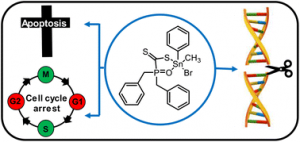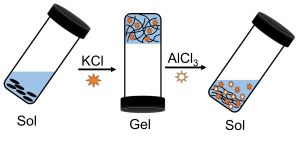Bio-Inorganic Chemistry
Anti-cancer Drugs
Platinum based drugs have been important in the treatment of cancer for decades, but these compounds displayed side effects making it difficult to distinguish their toxicity towards cancer cells from cytotoxicity. This led to an upsurge in anti-cancer drugs based on other metals and we have tested organo-tin compounds based on phosphinoyldithioformate ligand, which were excellent anti-cancer agent (Cancer Research, 2018, 78, 2807-2807) and the organo-tin compounds showed higher activity than cisplatin. We have been synthesizing complexes based on various ligands (amino acid) and rhodium(II)/tin(IV) compounds.
We reported two monoorganotin(IV) complexes based on a dibenzyl phosphinoyldithioformate (H-DBPTF) ligand, containing either bromide (Sn-DBPTF-1) or chloride (Sn-DBPTF-2) anions. Sn-DBPTF-1 was cytotoxic at IC50 <10 μg mL−1 against cancer cell lines A549 (lung cancer), Aspc-1 (pancreatic cancer), OVCAR-3 (ovarian cancer), T-47D (breast cancer) and HCT116 (colon cancer), and breast epithelial stem cell line D492. Dalton Trans, 2022, 51, 16316-16324
The anti-cancer activities of these complexes are studied at the Biomedical Centre in Prof. Helga M Ögmundsdóttir's, lab and we are trying to characterize the mode of action.
Anion Recognition
Anions are ubiquitous in biological systems that play significant roles in the wide areas of biology, pharmacy, and environmental science. The design of receptor systems for anion recognition has therefore developed into a key area of supramolecular chemistry, have received considerable attention due to their analytical applications. Among various anions of biological interest (halides, phosphates, sulphates etc.), considerable efforts have been devoted to detect and quantify phosphate anions. This is partly due to the important roles that anions play in biological systems (e.g. phosphorylated species) and the environment (e.g. cyanide and nitrate). However, the development of selective receptors for specific biological target in aqueous media is still a daunting task due to the high non-covalent affinity of water molecules with the substrates. Our aim is to develop novel chemical receptors for the efficient recognition of anions in gel state.
We have studied the role of geometry or extent of receptor–anion interaction in the presence of anions on the Supramolecular gel network RSC Adv., 2016, 6, 83303–83311.
We have shown the stimuli-responsive properties of bis(pyridyl-N-oxide urea) gelators and the role of anions in making and breaking the gel-network, Molecules, 2021, 26(21), 6420

